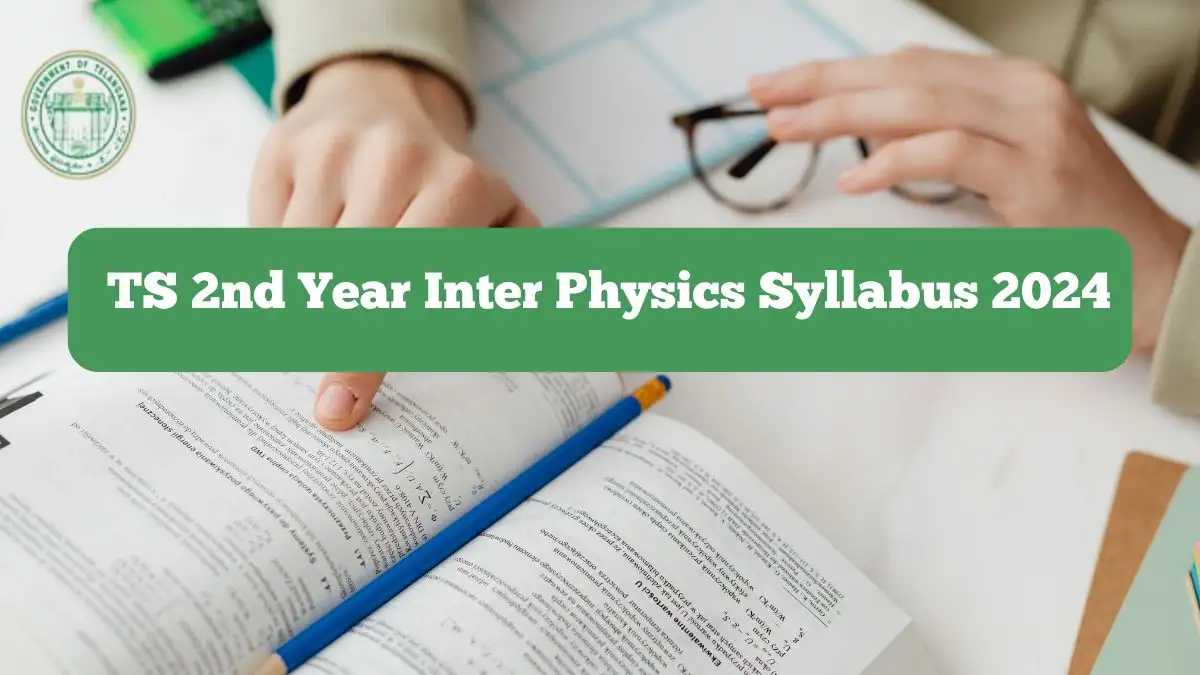TS 2nd Year Inter Physics Syllabus 2024-25: Click here for details
by Sivasankari
Updated Oct 10, 2024

TS Inter 2nd Year Physics Syllabus 2024-25: Download and Overview
The Physics syllabus is essential for 2nd year Science stream students, as it plays a significant role in both medical and engineering fields. Entrance examinations often feature a dedicated section for Physics, making it crucial for students to grasp the subject thoroughly.
This article provides the Telangana Board's 12th-grade Physics syllabus for the 2024-25 academic year. Students are encouraged to review the syllabus to ensure comprehensive knowledge and to excel in their Physics board exams in 2025. For better understanding, a complete academic calendar PDF is included. Be sure to study this information carefully during your revision to cover all topics effectively.
TS 2nd Year Physics Syllabus 2024-25
The Physics syllabus for the Telangana Board's 2nd year, intended for the 2025 board exams, is provided below. Please refer to the table that outlines all the topics to be covered during the 2024-25 academic year.
CHAPTER – 1: WAVES
1.1 Introduction
1.2 Transverse and Longitudinal waves
1.3 Displacement relation in a progressive wave
1.4 Speed of a Travelling Wave
1.5 The principle of superposition of waves
1.6 Reflection of waves
1.7 Beats
1.8 Doppler Effect
CHAPTER– 2: RAY OPTICS AND OPTICAL INSTRUMENTS
2.1 Introduction
2.2 Reflection of light by Spherical Mirrors
2.3 Refraction
2.4 Total Internal Reflection
2.5 Refraction at Spherical Surfaces and by Lenses.
2.6 Refraction through a prism
2.7 Dispersion by a Prism
2.8 Some Natural phenomena due to Sunlight
2.9 Optical Instruments
EAPSET Classes
EAPSET TEST-1
CHAPTER – 3: WAVE OPTICS
3.1 Introduction
3.2 Huygens Principle
3.3 Refraction and Reflection of plane waves using Huygens Principle
3.4 Coherent and Incoherent Addition of waves
3.5 Interference of Light waves and Young’s Experiment
3.6 Diffraction
3.7 Polarisation
CHAPTER – 4: ELECTRIC CHARGES AND FIELDS
4.1 Introduction
4.2 Electric Charges
4.3 Conductors and Insulators
4.4 Charging by Induction
4.5 Basic Properties of Electric Charge
4.6 Coulomb’s Law
4.7 Forces between Multiple charges
4.8 Electric Field
4.9 Electric Field Lines
4.10 Electric Flux
4.11 Electric Dipole
4.12 Dipole in a uniform external field
4.13 Continuous Charge Distribution
4.14 Gauss’s Law
4.15 Application of Gauss’ Law
EAPSET Classes
EAPSET TEST-2
Unit test 1
CHAPTER – 5: ELECTROSTATIC POTENTIAL AND CAPACITANCE
5.1 Introduction
5.2 Electrostatic Potential
5.3 Potential due to a point charge
5.4 Potential due to an Electric Dipole
5.5 Potential due to a System of Charges
5.6 Equipotential Surfaces
5.7 Potential Energy of a System of Charges
5.8 Potential Energy in an External field
5.9 Electrostatics of Conductors
5.10 Dielectrics and Polarisation
5.11 Capacitors and Capacitance
5.12 The Parallel Plate Capacitor
5.13 Effect of Dielectric on Capacitance
5.14 Combination of Capacitors
5.15 Energy Stored in a Capacitor
5.16 Van de Graaff Generator
CHAPTER – 6: CURRENT ELECTRICITY
6.1 Introduction
6.2 Electric current
6.3 Electric current in conductors
6.4 Ohm’s Law
6.5 Drift Electrons and Origin of Resistivity
6.6 Limitations of Ohm’s Law
6.7 Resistivity of various Materials
6.8 Temperature Dependence of Resistivity
6.9 Electric Energy, Power
6.10 Combination of Resistors – Series and Parallel
6.11 Cells, emf, Internal Resistance
6.12 Cells in Series and in Parallel
6.13 Kirchhoff’s Laws
6.14 Wheatstone Bridge
6.15 Meter Bridge
6.16 Potentiometer
EAPSET Classes
EAPSET TEST-3
Unit test -2
CHAPTER – 7: MOVING CHARGES AND MAGNETISM
7.1 Introduction
7.2 Magnetic Force
7.3 Motion in a Magnetic field
7.4 Motion in combined Electric and Magnetic Fields
7.5 Magnetic Field due to a Current Element, Biot-Savart Law
7.6 Magnetic Field on the Axis of a Circular Current Loop
7.7 Ampere’s Circuital Law
7.8 The Solenoid and the Toroid
7.9 Force between two Parallel Currents, The Ampere(Unit)
7.10 Torque on Current Loop, Magnetic Dipole
7.11 The Moving Coil Galvanometer
CHAPTER – 8: MAGNETISM AND MATTER
8.1 Introduction
8.2 The Bar Magnet
8.3 Magnetism and Gauss’s Law
8.4 The Earth’s Magnetism
8.5 Magnetisation and Magnetic Intensity
8.6 Magnetic Properties of Materials
8.7 Magnets and Electromagnets
CHAPTER – 9: ELECTROMAGNETIC INDUCTION
9.1 Introduction
9.2 The experiments of Faraday and Henry
9.3 Magnetic Flux
9.4 Faraday’s Law of Induction
9.5 Lenz’s Law and Conservation of Energy
9.6 Motional Electromotive Force
9.7 Energy consideration: A Quantitative Study
9.8 Eddy Currents
9.9 Inductance
9.10 AC Generator
EAPSET Classes
EAPSET TEST- 4
UNIT TEST 3
PRACTICALS:
5. Meter bridge
CHAPTER – 10: ALTERNATING CURRENT:
10.1 Introduction
10.2 AC voltage applied to a Resistor
10.3 Representation of AC Current and Voltage by Rotating Vectors - Phasors
10.4 AC voltage applied to an Inductor
10.5 AC voltage applied to a Capacitor
10.6 AC voltage applied to a Series LCR Circuit
10.7 Power in AC Circuit: The Power Factor
10.8 LC Oscillations
10.9 Transformers
EAMCET Class
CHAPTER – 11: ELECTROMAGNETIC WAVES
11.1 Introduction
11.2 Displacement Current
11.3 Electro Magnetic Waves
11.4 Electromagnetic Spectrum
EAPSET Classes
EAPSET TEST -5
CHAPTER – 12: DUAL NATURE OF RADIATION AND MATTER
12.1 Introduction
12.2 Electron Emission
12.3 Photoelectric Effect
12.4 Experimental Study of Photoelectric Effect
12.5 Photoelectric Effect and Wave Theory of Light
12.6 Einstein’s Photoelectric Equation: Energy Quantum of Radiation
12.7 Particle Nature of Light: The Photon
12.8 Wave Nature of Matter
12.9 Davisson and Germer Experiment
CHAPTER – 13: ATOMS
13.1 Introduction
13.2 Alpha-particle Scattering and Rutherford’s Nuclear model of Atom
13.3 Atomic Spectra
13.4 Bohr Model of the Hydrogen Atom
13.5 The Line Spectra of the Hydrogen Atom
13.6 De Broglie’s Explanation of Bohr’s Second Postulate of Quantisation
EAPSET Classes
HALF YEARLY EXAMINATIONS: 18-11-2024 TO 23-11-2024
CHAPTER – 14: NUCLEI
14.1 Introduction
14.2 Atomic Masses and Composition of Nucleus
14.3 Size of the Nucleus
14.4 Mass-Energy and Nuclear Binding Energy
14.5 Nuclear Force
14.6 Radioactivity
14.7 Nuclear Energy
CHAPTER – 15: SEMICONDUCTOR ELECTRONICS: MATERIALS, DEVICES AND SIMPLE CIRCUITS
15.1 Introduction
15.2 Classification of Metals, Conductors and Semiconductors
15.3 Intrinsic Semiconductor
15.4 Extrinsic Semiconductor
15.5 p – n junction
15.6 Semiconductor diode
15.7 Application of Junction Diode as a Rectifier
15.8 Special Purpose p-n Junction Diodes
15.9 Junction Transistor
15.10 Digital Electronics and Logic Gates
15.11 Integrated Circuits
CHAPTER – 16: COMMUNICATION SYSTEMS
16.1 Introduction
16.2 Elements of communication system
16.3 Basic Terminology used in Electronic Communication Systems
16.4 Bandwidth of Signals
16.5 Bandwidth of Transmission Medium
16.6 Propagation of Electromagnetic Waves
16.7 Modulation and its Necessity
16.8 Amplitude Modulation
16.9 Production of Amplitude Modulated Wave
16.10 Detection of Amplitude Modulated Wave
EAPSET Classes
EAPSET TEST–6
UNIT TEST–4
PRACTICALS:
8. Tangent Galvanometer
9. P-N Junction diode
10. Transistor Characteristics
TS Inter 2nd Year Physics Syllabus 2024-25 - FAQs
The Physics syllabus is crucial for 2nd year Science stream students as it lays the foundation for various medical and engineering entrance examinations, emphasizing the need for a strong grasp of the subject.
Major chapters include Waves, Ray Optics and Optical Instruments, Wave Optics, Electric Charges and Fields, Electrostatic Potential and Capacitance, Current Electricity, Moving Charges and Magnetism, and many more, covering a total of 16 chapters.




